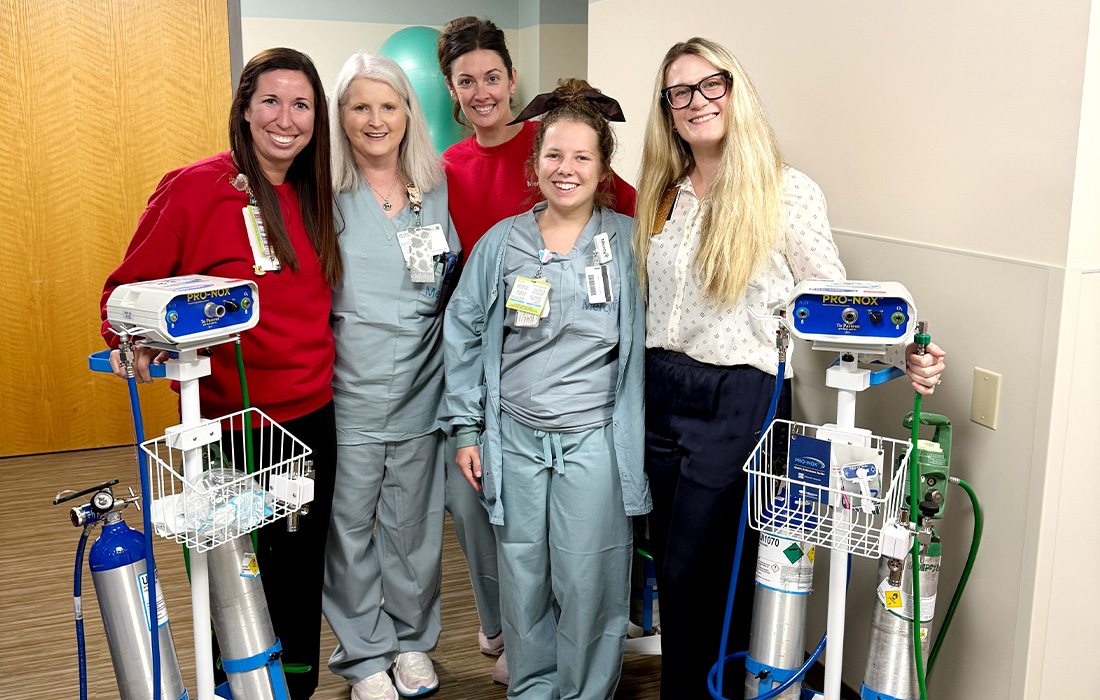
Top Doctors
How Mercy’s New Nitrous Oxide for Labor Pain Relief Works
Expectant mothers at Mercy Hospital Springfield can now choose nitrous oxide during labor, a self-administered option that eases pain, reduces anxiety and allows greater mobility than traditional pain-relief methods.
By Jordan Blomquist
Sep 2025

A new pain management option is available for birthing mothers at Mercy Hospital Springfield.
PRESENTED BY
Nitrous oxide, a safe and self-administered gas mixture, is now part of Mercy’s labor and delivery offerings, giving mothers more flexibility, comfort and control over their birth experience. Here’s everything we know.
Why Nitrous Oxide Matters
Historically, labor pain relief options have been limited: epidurals, IV pain medication or no medication at all. Nitrous oxide fills the gap in between.
“It doesn't have to be about, ‘you can choose an epidural or choose nothing,’” says Brittany Shaar, nurse manager of Labor and Delivery and the Family Resource Center at Mercy, who points out that nitrous oxide gives women the ability to stay mobile, use gravity to their advantage during labor and still have support for managing pain. “It’s really about expanding options for women and empowering moms with greater autonomy—allowing them to have real-time control over their pain management and birth experience as much as possible,” Shaar says.
The gas, administered as a 50/50 mix of nitrous oxide and oxygen, is not considered a medication, but an analgesic. Unlike nitrous oxide someone might receive at a dentist’s office, which is delivered continuously, laboring mothers inhale it only during contractions. Its effects are short-lived, helping mothers relax, reduce anxiety and “care less” about the pain without losing mobility or awareness.
Benefits Compared to Other Pain Relief Options
There are many benefits to choosing nitrous oxide over other current pain management options.
• More mobility than an epidural: Mothers can walk, change positions and use birthing tools such as birthing balls.
• Fewer risks compared to IV pain medication: Nitrous oxide does not affect the baby’s breathing, so it can be used later in labor.
• Short-acting and self-controlled: Mothers decide when to use it, breathing it in only during contractions or when pain relief is needed.
• Option for those who can’t have an epidural: For patients with low platelets, prior back surgery or other medical concerns, nitrous oxide provides pain relief when epidurals aren’t possible, including for those who arrive late and/or progress too quickly to receive an epidural.
How Mercy Brought Nitrous Oxide to Springfield
Nitrous oxide has been widely used overseas for decades. Mercy’s leadership saw an opportunity to meet patient demand, and Mercy Health Foundation’s local chapter of Women with a Mission helped make it possible.
When local birthing centers that offered nitrous oxide closed, expectant mothers began calling Mercy to ask if it was available. Mercy’s Women’s and Children’s Services team worked with the Mercy Health Foundation to fund the necessary equipment. “This was born out of conversations from patients,” says Jennifer Murray, Director of Women’s & Children’s Services and Behavioral Health at Mercy. Women wanted more options, and Mercy wanted to meet them where they were.
Part of Mercy’s Low-Intervention Birth Program
Nitrous oxide complements Mercy’s low-intervention birth program, which offers a home-like environment within the safety of the hospital. Mercy’s low-intervention suites include:
• Hydrotherapy tubs for labor comfort (water labor, not water birth)
• Doppler monitoring instead of continuous fetal monitoring for eligible patients
• Freedom of movement during labor
• Specialized birthing beds and Vibwife oscillating mattresses to support comfortable positioning and steady labor progress
The program was designed to give women the experience they want, whether that’s an unmedicated birth, an epidural or something in between. Rather than women choosing to deliver at home without access to emergency care, Mercy aims to offer that same experience within the safety net of a hospital. “Where we have resources, an OR, we have physicians ready to go and staff members that can help,” Shaar says.
Planning Your Birth at Mercy
Mercy encourages mothers to start birth planning early, ideally with their physician or midwife at the first prenatal visit. Patients can also attend Mercy’s free childbirth preparation classes, which cover pain relief options and what to expect during delivery.
Birth plans can include everything from pain management preferences to room environment requests, such as dim lighting, quiet voices or immediate skin-to-skin contact. “We see you, we hear you and our goal here is to provide the kind of individualized experience that you want when you’re giving birth,” Murray says. “We want to be a really fantastic part of your story.”













